Negligent Misstatement & Economic Loss
VerifiedAdded on 2020/03/04
|9
|1894
|49
AI Summary
This assignment examines a scenario involving Steve and George, who provide negligent financial advice to Harry, Zara, and Hilary regarding the Sydney real estate market. The students are tasked with applying legal principles like Hedley Byrne & Co Ltd v Heller & Partners Ltd and the Civil Liability Act 2002 (NSW) to analyze whether Harry, Zara, and Hilary have grounds for a successful negligence lawsuit against Steve and George. The case study explores the concept of negligent misstatement, reliance on advice, economic loss, and potential damages for both financial and psychological harm.
Contribute Materials
Your contribution can guide someone’s learning journey. Share your
documents today.
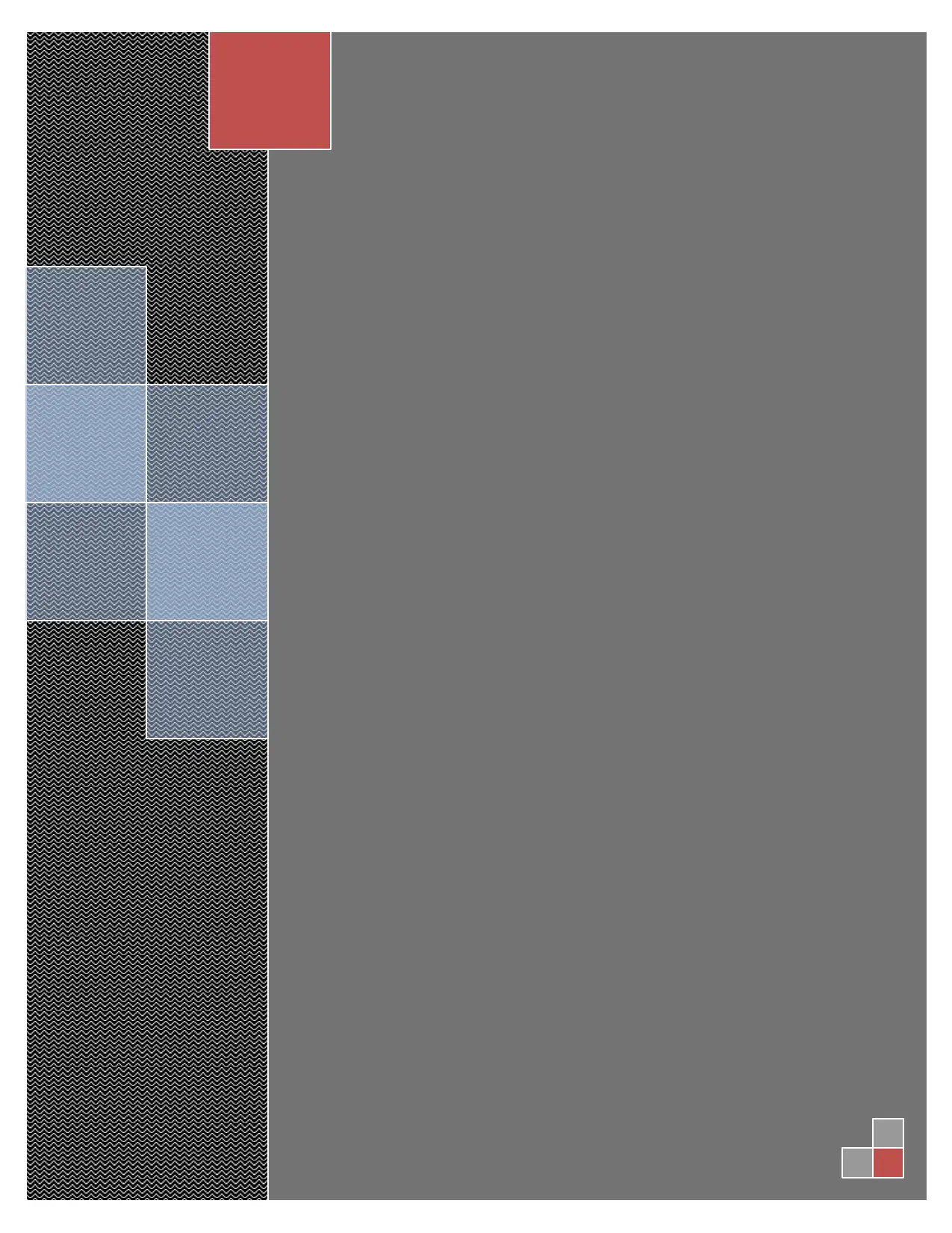
Secure Best Marks with AI Grader
Need help grading? Try our AI Grader for instant feedback on your assignments.
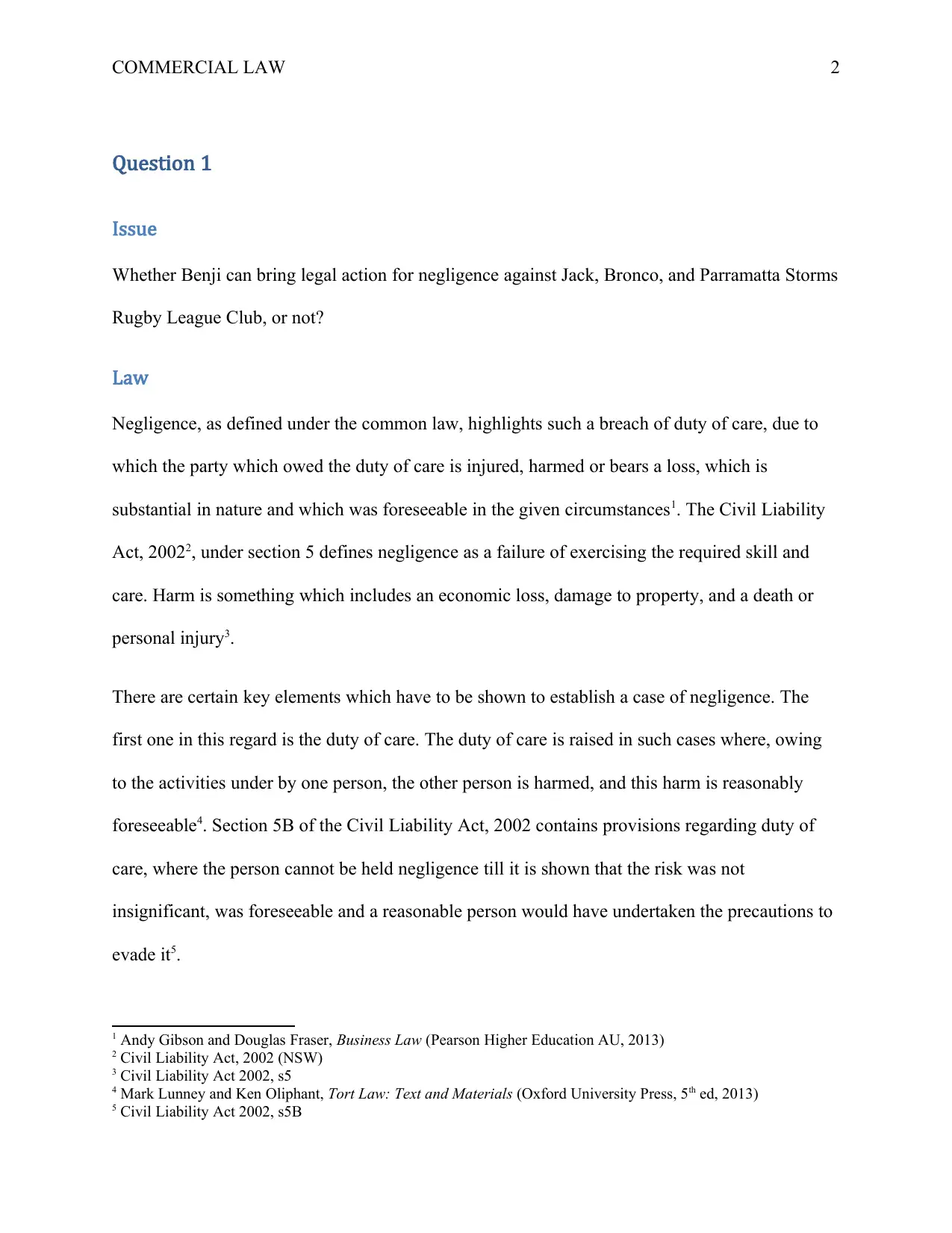
COMMERCIAL LAW 2
Question 1
Issue
Whether Benji can bring legal action for negligence against Jack, Bronco, and Parramatta Storms
Rugby League Club, or not?
Law
Negligence, as defined under the common law, highlights such a breach of duty of care, due to
which the party which owed the duty of care is injured, harmed or bears a loss, which is
substantial in nature and which was foreseeable in the given circumstances1. The Civil Liability
Act, 20022, under section 5 defines negligence as a failure of exercising the required skill and
care. Harm is something which includes an economic loss, damage to property, and a death or
personal injury3.
There are certain key elements which have to be shown to establish a case of negligence. The
first one in this regard is the duty of care. The duty of care is raised in such cases where, owing
to the activities under by one person, the other person is harmed, and this harm is reasonably
foreseeable4. Section 5B of the Civil Liability Act, 2002 contains provisions regarding duty of
care, where the person cannot be held negligence till it is shown that the risk was not
insignificant, was foreseeable and a reasonable person would have undertaken the precautions to
evade it5.
1 Andy Gibson and Douglas Fraser, Business Law (Pearson Higher Education AU, 2013)
2 Civil Liability Act, 2002 (NSW)
3 Civil Liability Act 2002, s5
4 Mark Lunney and Ken Oliphant, Tort Law: Text and Materials (Oxford University Press, 5th ed, 2013)
5 Civil Liability Act 2002, s5B
Question 1
Issue
Whether Benji can bring legal action for negligence against Jack, Bronco, and Parramatta Storms
Rugby League Club, or not?
Law
Negligence, as defined under the common law, highlights such a breach of duty of care, due to
which the party which owed the duty of care is injured, harmed or bears a loss, which is
substantial in nature and which was foreseeable in the given circumstances1. The Civil Liability
Act, 20022, under section 5 defines negligence as a failure of exercising the required skill and
care. Harm is something which includes an economic loss, damage to property, and a death or
personal injury3.
There are certain key elements which have to be shown to establish a case of negligence. The
first one in this regard is the duty of care. The duty of care is raised in such cases where, owing
to the activities under by one person, the other person is harmed, and this harm is reasonably
foreseeable4. Section 5B of the Civil Liability Act, 2002 contains provisions regarding duty of
care, where the person cannot be held negligence till it is shown that the risk was not
insignificant, was foreseeable and a reasonable person would have undertaken the precautions to
evade it5.
1 Andy Gibson and Douglas Fraser, Business Law (Pearson Higher Education AU, 2013)
2 Civil Liability Act, 2002 (NSW)
3 Civil Liability Act 2002, s5
4 Mark Lunney and Ken Oliphant, Tort Law: Text and Materials (Oxford University Press, 5th ed, 2013)
5 Civil Liability Act 2002, s5B
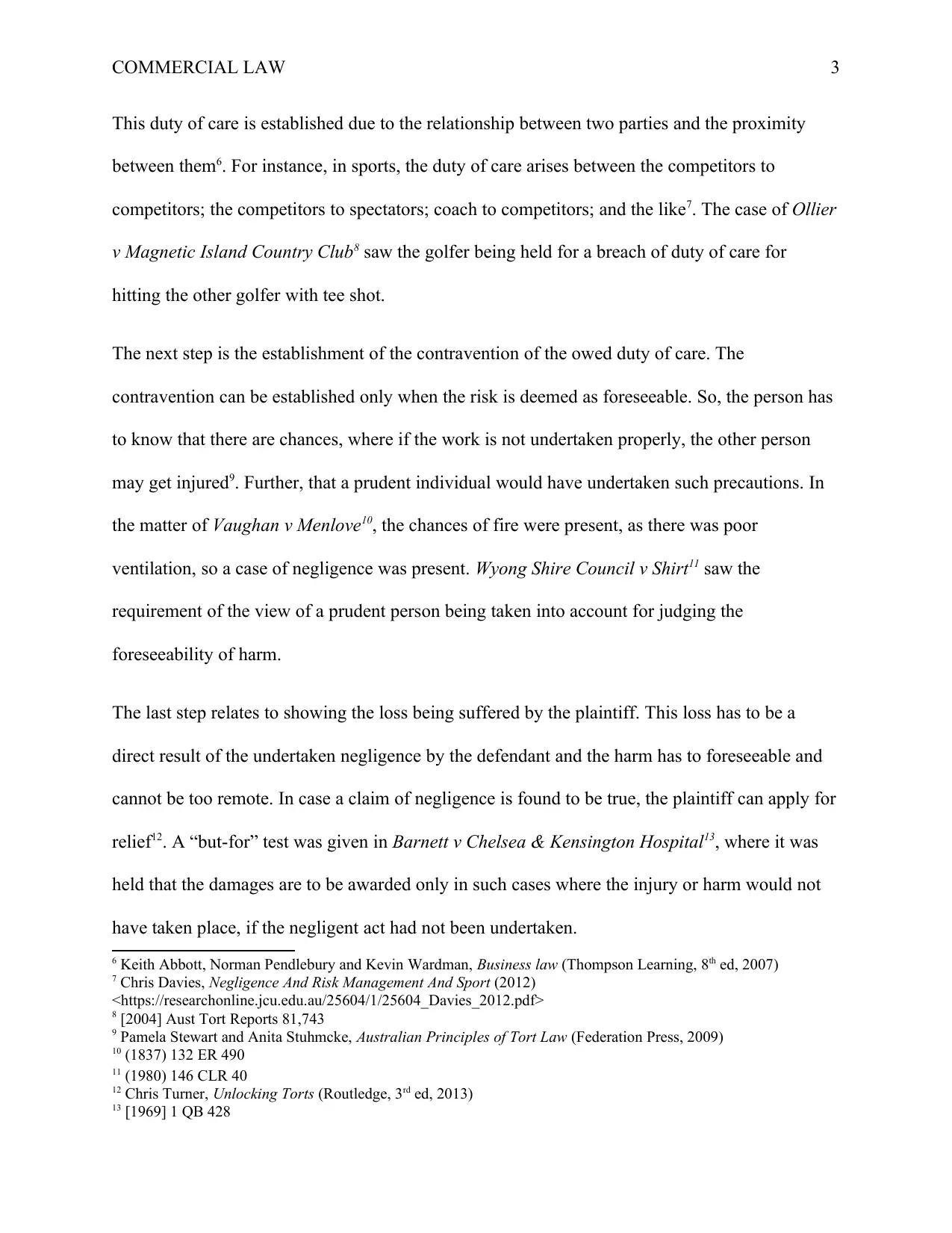
COMMERCIAL LAW 3
This duty of care is established due to the relationship between two parties and the proximity
between them6. For instance, in sports, the duty of care arises between the competitors to
competitors; the competitors to spectators; coach to competitors; and the like7. The case of Ollier
v Magnetic Island Country Club8 saw the golfer being held for a breach of duty of care for
hitting the other golfer with tee shot.
The next step is the establishment of the contravention of the owed duty of care. The
contravention can be established only when the risk is deemed as foreseeable. So, the person has
to know that there are chances, where if the work is not undertaken properly, the other person
may get injured9. Further, that a prudent individual would have undertaken such precautions. In
the matter of Vaughan v Menlove10, the chances of fire were present, as there was poor
ventilation, so a case of negligence was present. Wyong Shire Council v Shirt11 saw the
requirement of the view of a prudent person being taken into account for judging the
foreseeability of harm.
The last step relates to showing the loss being suffered by the plaintiff. This loss has to be a
direct result of the undertaken negligence by the defendant and the harm has to foreseeable and
cannot be too remote. In case a claim of negligence is found to be true, the plaintiff can apply for
relief12. A “but-for” test was given in Barnett v Chelsea & Kensington Hospital13, where it was
held that the damages are to be awarded only in such cases where the injury or harm would not
have taken place, if the negligent act had not been undertaken.
6 Keith Abbott, Norman Pendlebury and Kevin Wardman, Business law (Thompson Learning, 8th ed, 2007)
7 Chris Davies, Negligence And Risk Management And Sport (2012)
<https://researchonline.jcu.edu.au/25604/1/25604_Davies_2012.pdf>
8 [2004] Aust Tort Reports 81,743
9 Pamela Stewart and Anita Stuhmcke, Australian Principles of Tort Law (Federation Press, 2009)
10 (1837) 132 ER 490
11 (1980) 146 CLR 40
12 Chris Turner, Unlocking Torts (Routledge, 3rd ed, 2013)
13 [1969] 1 QB 428
This duty of care is established due to the relationship between two parties and the proximity
between them6. For instance, in sports, the duty of care arises between the competitors to
competitors; the competitors to spectators; coach to competitors; and the like7. The case of Ollier
v Magnetic Island Country Club8 saw the golfer being held for a breach of duty of care for
hitting the other golfer with tee shot.
The next step is the establishment of the contravention of the owed duty of care. The
contravention can be established only when the risk is deemed as foreseeable. So, the person has
to know that there are chances, where if the work is not undertaken properly, the other person
may get injured9. Further, that a prudent individual would have undertaken such precautions. In
the matter of Vaughan v Menlove10, the chances of fire were present, as there was poor
ventilation, so a case of negligence was present. Wyong Shire Council v Shirt11 saw the
requirement of the view of a prudent person being taken into account for judging the
foreseeability of harm.
The last step relates to showing the loss being suffered by the plaintiff. This loss has to be a
direct result of the undertaken negligence by the defendant and the harm has to foreseeable and
cannot be too remote. In case a claim of negligence is found to be true, the plaintiff can apply for
relief12. A “but-for” test was given in Barnett v Chelsea & Kensington Hospital13, where it was
held that the damages are to be awarded only in such cases where the injury or harm would not
have taken place, if the negligent act had not been undertaken.
6 Keith Abbott, Norman Pendlebury and Kevin Wardman, Business law (Thompson Learning, 8th ed, 2007)
7 Chris Davies, Negligence And Risk Management And Sport (2012)
<https://researchonline.jcu.edu.au/25604/1/25604_Davies_2012.pdf>
8 [2004] Aust Tort Reports 81,743
9 Pamela Stewart and Anita Stuhmcke, Australian Principles of Tort Law (Federation Press, 2009)
10 (1837) 132 ER 490
11 (1980) 146 CLR 40
12 Chris Turner, Unlocking Torts (Routledge, 3rd ed, 2013)
13 [1969] 1 QB 428
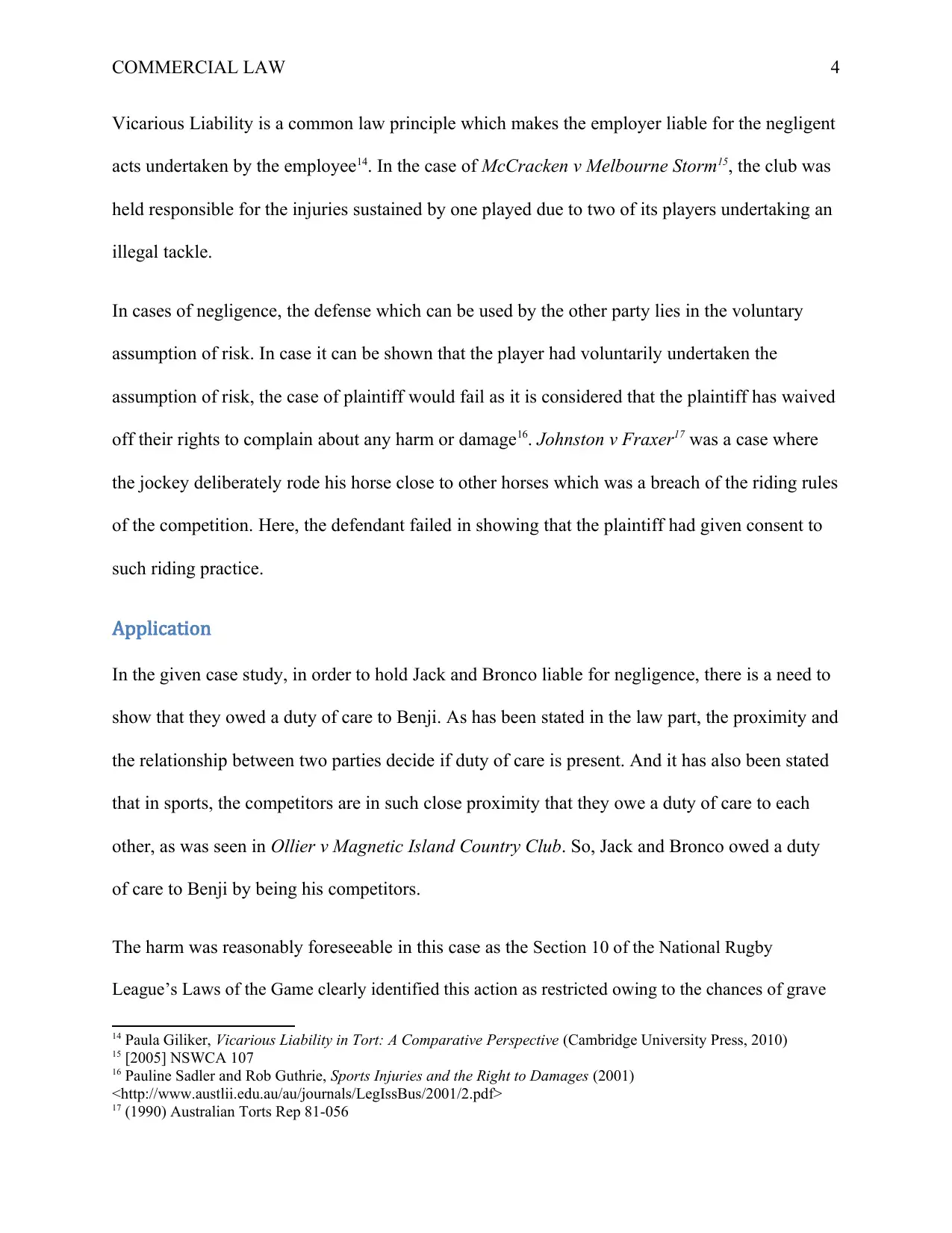
COMMERCIAL LAW 4
Vicarious Liability is a common law principle which makes the employer liable for the negligent
acts undertaken by the employee14. In the case of McCracken v Melbourne Storm15, the club was
held responsible for the injuries sustained by one played due to two of its players undertaking an
illegal tackle.
In cases of negligence, the defense which can be used by the other party lies in the voluntary
assumption of risk. In case it can be shown that the player had voluntarily undertaken the
assumption of risk, the case of plaintiff would fail as it is considered that the plaintiff has waived
off their rights to complain about any harm or damage16. Johnston v Fraxer17 was a case where
the jockey deliberately rode his horse close to other horses which was a breach of the riding rules
of the competition. Here, the defendant failed in showing that the plaintiff had given consent to
such riding practice.
Application
In the given case study, in order to hold Jack and Bronco liable for negligence, there is a need to
show that they owed a duty of care to Benji. As has been stated in the law part, the proximity and
the relationship between two parties decide if duty of care is present. And it has also been stated
that in sports, the competitors are in such close proximity that they owe a duty of care to each
other, as was seen in Ollier v Magnetic Island Country Club. So, Jack and Bronco owed a duty
of care to Benji by being his competitors.
The harm was reasonably foreseeable in this case as the Section 10 of the National Rugby
League’s Laws of the Game clearly identified this action as restricted owing to the chances of grave
14 Paula Giliker, Vicarious Liability in Tort: A Comparative Perspective (Cambridge University Press, 2010)
15 [2005] NSWCA 107
16 Pauline Sadler and Rob Guthrie, Sports Injuries and the Right to Damages (2001)
<http://www.austlii.edu.au/au/journals/LegIssBus/2001/2.pdf>
17 (1990) Australian Torts Rep 81-056
Vicarious Liability is a common law principle which makes the employer liable for the negligent
acts undertaken by the employee14. In the case of McCracken v Melbourne Storm15, the club was
held responsible for the injuries sustained by one played due to two of its players undertaking an
illegal tackle.
In cases of negligence, the defense which can be used by the other party lies in the voluntary
assumption of risk. In case it can be shown that the player had voluntarily undertaken the
assumption of risk, the case of plaintiff would fail as it is considered that the plaintiff has waived
off their rights to complain about any harm or damage16. Johnston v Fraxer17 was a case where
the jockey deliberately rode his horse close to other horses which was a breach of the riding rules
of the competition. Here, the defendant failed in showing that the plaintiff had given consent to
such riding practice.
Application
In the given case study, in order to hold Jack and Bronco liable for negligence, there is a need to
show that they owed a duty of care to Benji. As has been stated in the law part, the proximity and
the relationship between two parties decide if duty of care is present. And it has also been stated
that in sports, the competitors are in such close proximity that they owe a duty of care to each
other, as was seen in Ollier v Magnetic Island Country Club. So, Jack and Bronco owed a duty
of care to Benji by being his competitors.
The harm was reasonably foreseeable in this case as the Section 10 of the National Rugby
League’s Laws of the Game clearly identified this action as restricted owing to the chances of grave
14 Paula Giliker, Vicarious Liability in Tort: A Comparative Perspective (Cambridge University Press, 2010)
15 [2005] NSWCA 107
16 Pauline Sadler and Rob Guthrie, Sports Injuries and the Right to Damages (2001)
<http://www.austlii.edu.au/au/journals/LegIssBus/2001/2.pdf>
17 (1990) Australian Torts Rep 81-056
Secure Best Marks with AI Grader
Need help grading? Try our AI Grader for instant feedback on your assignments.
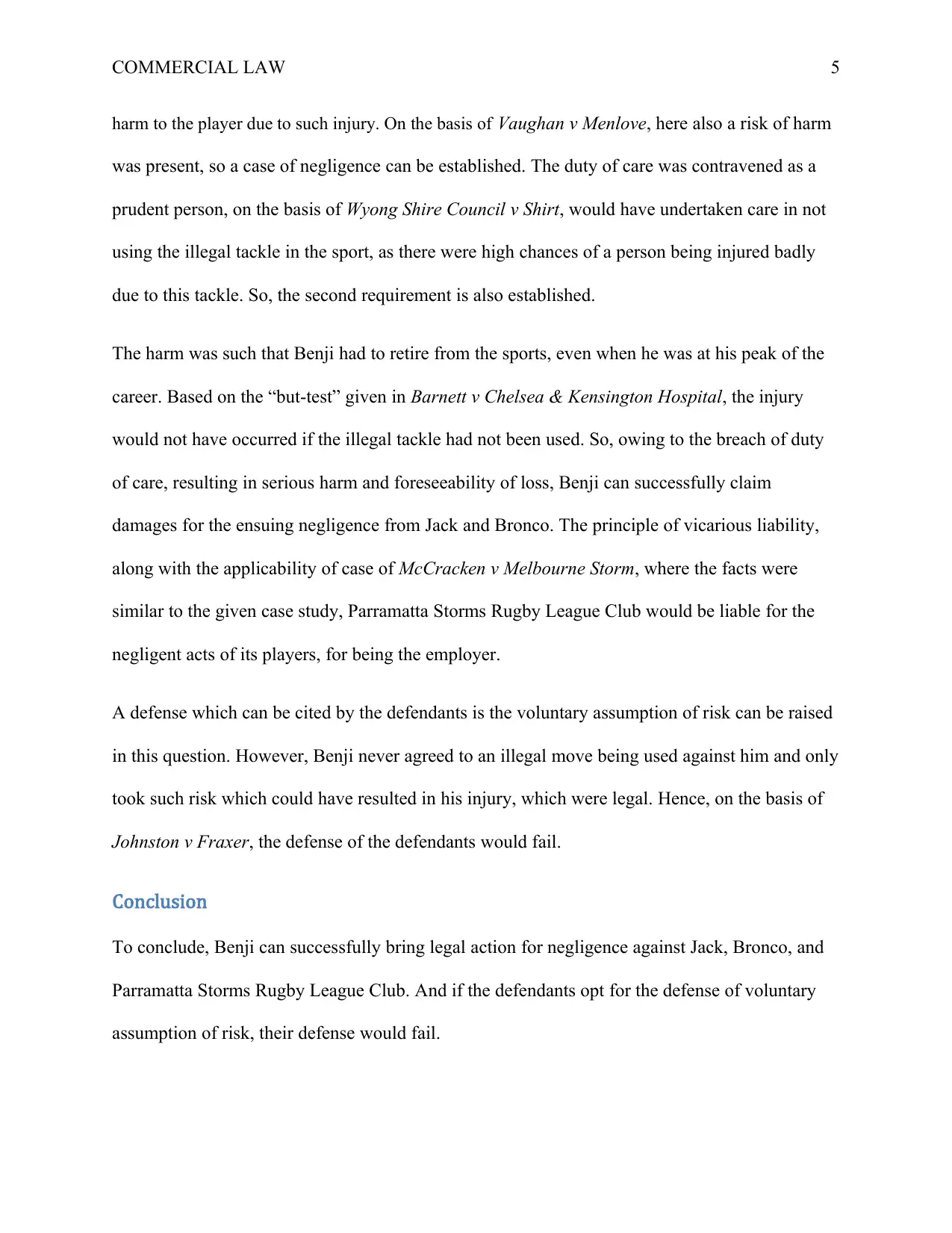
COMMERCIAL LAW 5
harm to the player due to such injury. On the basis of Vaughan v Menlove, here also a risk of harm
was present, so a case of negligence can be established. The duty of care was contravened as a
prudent person, on the basis of Wyong Shire Council v Shirt, would have undertaken care in not
using the illegal tackle in the sport, as there were high chances of a person being injured badly
due to this tackle. So, the second requirement is also established.
The harm was such that Benji had to retire from the sports, even when he was at his peak of the
career. Based on the “but-test” given in Barnett v Chelsea & Kensington Hospital, the injury
would not have occurred if the illegal tackle had not been used. So, owing to the breach of duty
of care, resulting in serious harm and foreseeability of loss, Benji can successfully claim
damages for the ensuing negligence from Jack and Bronco. The principle of vicarious liability,
along with the applicability of case of McCracken v Melbourne Storm, where the facts were
similar to the given case study, Parramatta Storms Rugby League Club would be liable for the
negligent acts of its players, for being the employer.
A defense which can be cited by the defendants is the voluntary assumption of risk can be raised
in this question. However, Benji never agreed to an illegal move being used against him and only
took such risk which could have resulted in his injury, which were legal. Hence, on the basis of
Johnston v Fraxer, the defense of the defendants would fail.
Conclusion
To conclude, Benji can successfully bring legal action for negligence against Jack, Bronco, and
Parramatta Storms Rugby League Club. And if the defendants opt for the defense of voluntary
assumption of risk, their defense would fail.
harm to the player due to such injury. On the basis of Vaughan v Menlove, here also a risk of harm
was present, so a case of negligence can be established. The duty of care was contravened as a
prudent person, on the basis of Wyong Shire Council v Shirt, would have undertaken care in not
using the illegal tackle in the sport, as there were high chances of a person being injured badly
due to this tackle. So, the second requirement is also established.
The harm was such that Benji had to retire from the sports, even when he was at his peak of the
career. Based on the “but-test” given in Barnett v Chelsea & Kensington Hospital, the injury
would not have occurred if the illegal tackle had not been used. So, owing to the breach of duty
of care, resulting in serious harm and foreseeability of loss, Benji can successfully claim
damages for the ensuing negligence from Jack and Bronco. The principle of vicarious liability,
along with the applicability of case of McCracken v Melbourne Storm, where the facts were
similar to the given case study, Parramatta Storms Rugby League Club would be liable for the
negligent acts of its players, for being the employer.
A defense which can be cited by the defendants is the voluntary assumption of risk can be raised
in this question. However, Benji never agreed to an illegal move being used against him and only
took such risk which could have resulted in his injury, which were legal. Hence, on the basis of
Johnston v Fraxer, the defense of the defendants would fail.
Conclusion
To conclude, Benji can successfully bring legal action for negligence against Jack, Bronco, and
Parramatta Storms Rugby League Club. And if the defendants opt for the defense of voluntary
assumption of risk, their defense would fail.
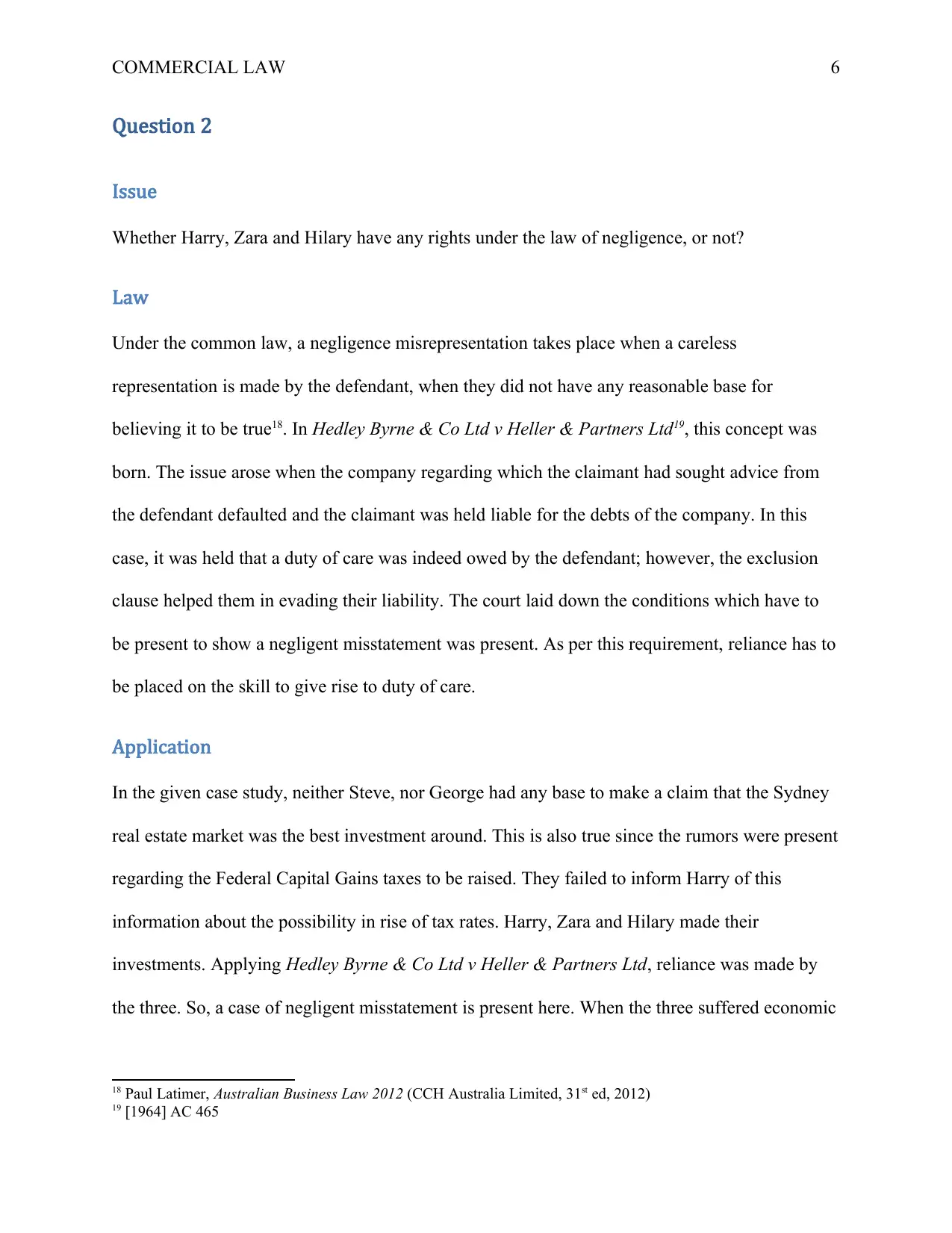
COMMERCIAL LAW 6
Question 2
Issue
Whether Harry, Zara and Hilary have any rights under the law of negligence, or not?
Law
Under the common law, a negligence misrepresentation takes place when a careless
representation is made by the defendant, when they did not have any reasonable base for
believing it to be true18. In Hedley Byrne & Co Ltd v Heller & Partners Ltd19, this concept was
born. The issue arose when the company regarding which the claimant had sought advice from
the defendant defaulted and the claimant was held liable for the debts of the company. In this
case, it was held that a duty of care was indeed owed by the defendant; however, the exclusion
clause helped them in evading their liability. The court laid down the conditions which have to
be present to show a negligent misstatement was present. As per this requirement, reliance has to
be placed on the skill to give rise to duty of care.
Application
In the given case study, neither Steve, nor George had any base to make a claim that the Sydney
real estate market was the best investment around. This is also true since the rumors were present
regarding the Federal Capital Gains taxes to be raised. They failed to inform Harry of this
information about the possibility in rise of tax rates. Harry, Zara and Hilary made their
investments. Applying Hedley Byrne & Co Ltd v Heller & Partners Ltd, reliance was made by
the three. So, a case of negligent misstatement is present here. When the three suffered economic
18 Paul Latimer, Australian Business Law 2012 (CCH Australia Limited, 31st ed, 2012)
19 [1964] AC 465
Question 2
Issue
Whether Harry, Zara and Hilary have any rights under the law of negligence, or not?
Law
Under the common law, a negligence misrepresentation takes place when a careless
representation is made by the defendant, when they did not have any reasonable base for
believing it to be true18. In Hedley Byrne & Co Ltd v Heller & Partners Ltd19, this concept was
born. The issue arose when the company regarding which the claimant had sought advice from
the defendant defaulted and the claimant was held liable for the debts of the company. In this
case, it was held that a duty of care was indeed owed by the defendant; however, the exclusion
clause helped them in evading their liability. The court laid down the conditions which have to
be present to show a negligent misstatement was present. As per this requirement, reliance has to
be placed on the skill to give rise to duty of care.
Application
In the given case study, neither Steve, nor George had any base to make a claim that the Sydney
real estate market was the best investment around. This is also true since the rumors were present
regarding the Federal Capital Gains taxes to be raised. They failed to inform Harry of this
information about the possibility in rise of tax rates. Harry, Zara and Hilary made their
investments. Applying Hedley Byrne & Co Ltd v Heller & Partners Ltd, reliance was made by
the three. So, a case of negligent misstatement is present here. When the three suffered economic
18 Paul Latimer, Australian Business Law 2012 (CCH Australia Limited, 31st ed, 2012)
19 [1964] AC 465
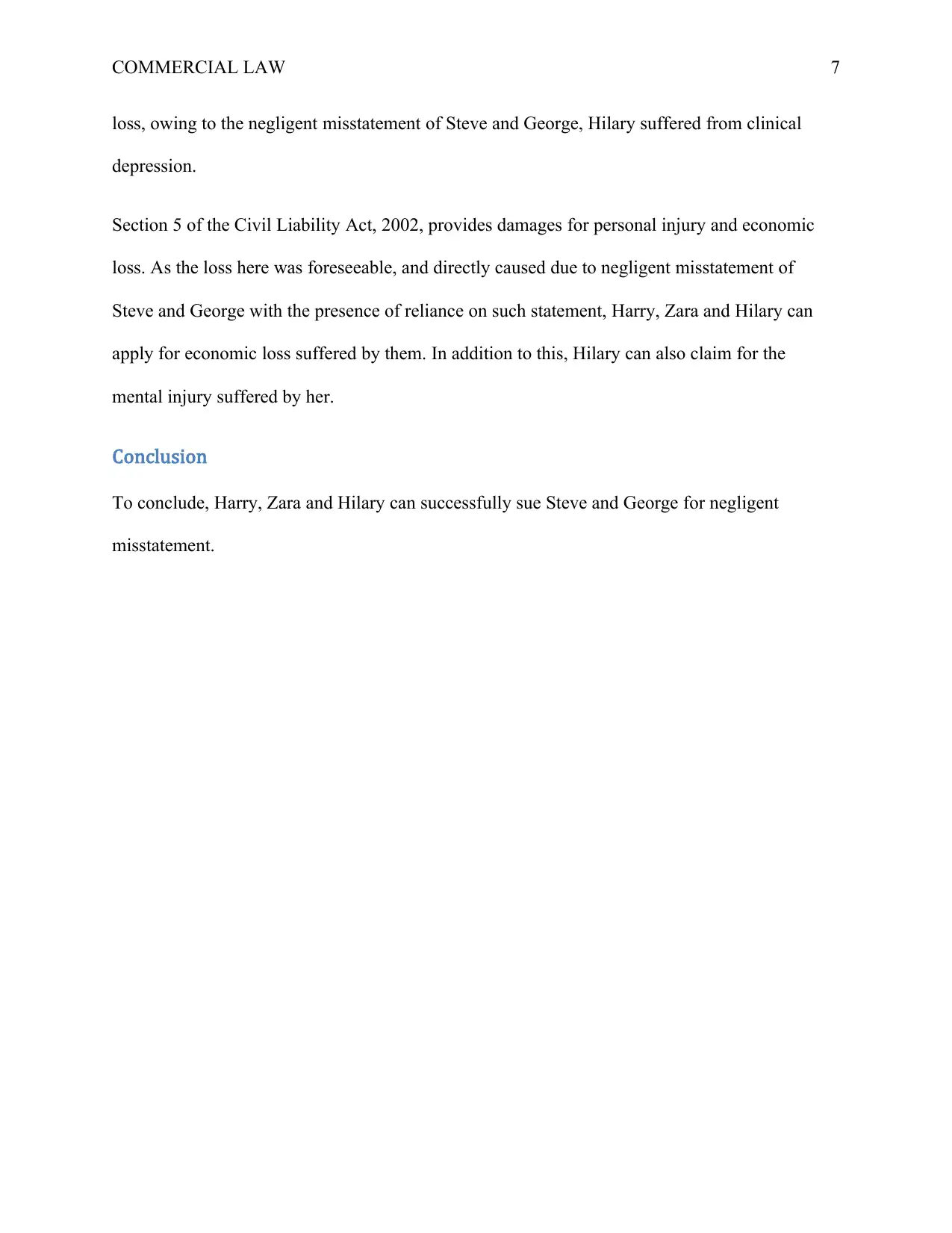
COMMERCIAL LAW 7
loss, owing to the negligent misstatement of Steve and George, Hilary suffered from clinical
depression.
Section 5 of the Civil Liability Act, 2002, provides damages for personal injury and economic
loss. As the loss here was foreseeable, and directly caused due to negligent misstatement of
Steve and George with the presence of reliance on such statement, Harry, Zara and Hilary can
apply for economic loss suffered by them. In addition to this, Hilary can also claim for the
mental injury suffered by her.
Conclusion
To conclude, Harry, Zara and Hilary can successfully sue Steve and George for negligent
misstatement.
loss, owing to the negligent misstatement of Steve and George, Hilary suffered from clinical
depression.
Section 5 of the Civil Liability Act, 2002, provides damages for personal injury and economic
loss. As the loss here was foreseeable, and directly caused due to negligent misstatement of
Steve and George with the presence of reliance on such statement, Harry, Zara and Hilary can
apply for economic loss suffered by them. In addition to this, Hilary can also claim for the
mental injury suffered by her.
Conclusion
To conclude, Harry, Zara and Hilary can successfully sue Steve and George for negligent
misstatement.
Paraphrase This Document
Need a fresh take? Get an instant paraphrase of this document with our AI Paraphraser
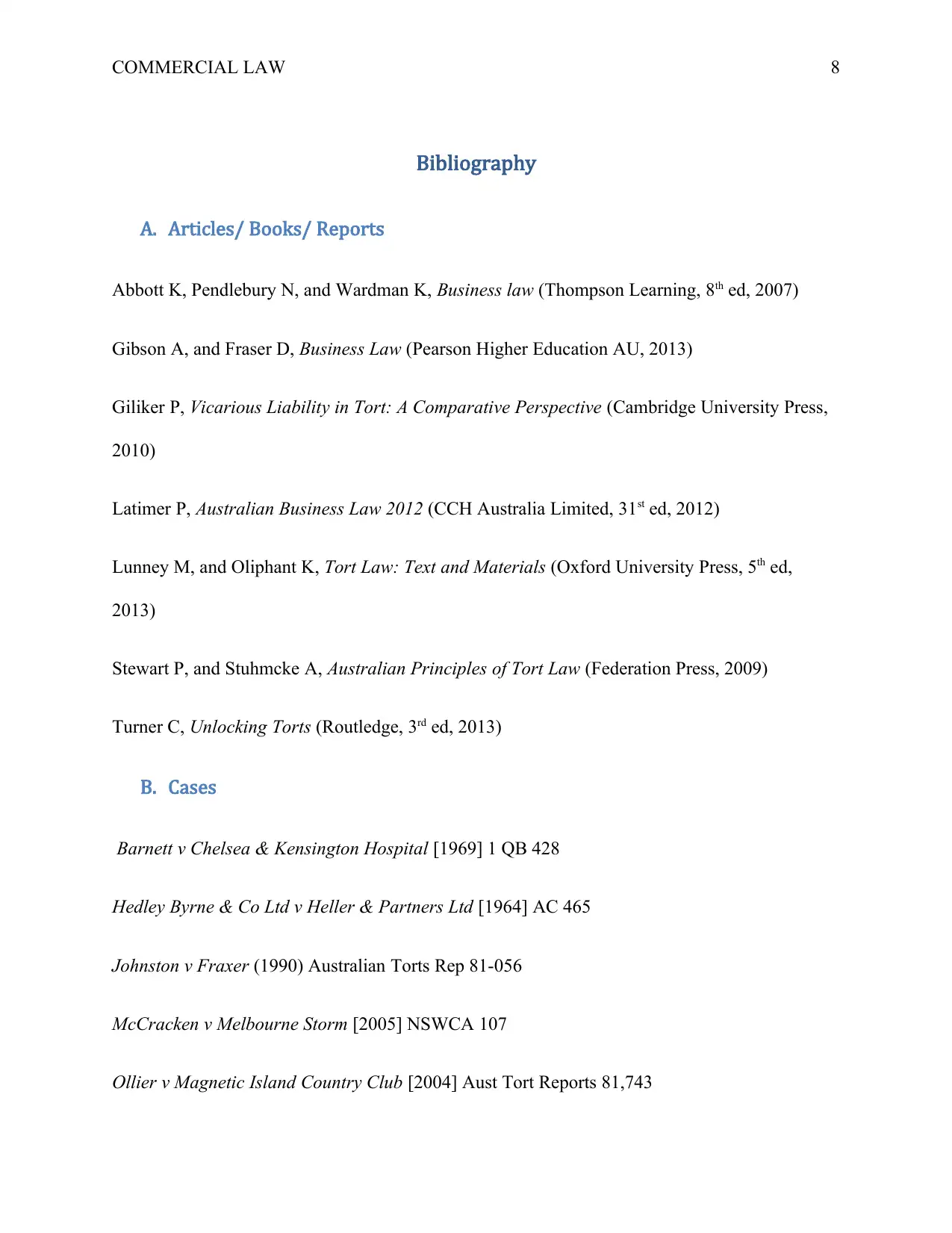
COMMERCIAL LAW 8
Bibliography
A. Articles/ Books/ Reports
Abbott K, Pendlebury N, and Wardman K, Business law (Thompson Learning, 8th ed, 2007)
Gibson A, and Fraser D, Business Law (Pearson Higher Education AU, 2013)
Giliker P, Vicarious Liability in Tort: A Comparative Perspective (Cambridge University Press,
2010)
Latimer P, Australian Business Law 2012 (CCH Australia Limited, 31st ed, 2012)
Lunney M, and Oliphant K, Tort Law: Text and Materials (Oxford University Press, 5th ed,
2013)
Stewart P, and Stuhmcke A, Australian Principles of Tort Law (Federation Press, 2009)
Turner C, Unlocking Torts (Routledge, 3rd ed, 2013)
B. Cases
Barnett v Chelsea & Kensington Hospital [1969] 1 QB 428
Hedley Byrne & Co Ltd v Heller & Partners Ltd [1964] AC 465
Johnston v Fraxer (1990) Australian Torts Rep 81-056
McCracken v Melbourne Storm [2005] NSWCA 107
Ollier v Magnetic Island Country Club [2004] Aust Tort Reports 81,743
Bibliography
A. Articles/ Books/ Reports
Abbott K, Pendlebury N, and Wardman K, Business law (Thompson Learning, 8th ed, 2007)
Gibson A, and Fraser D, Business Law (Pearson Higher Education AU, 2013)
Giliker P, Vicarious Liability in Tort: A Comparative Perspective (Cambridge University Press,
2010)
Latimer P, Australian Business Law 2012 (CCH Australia Limited, 31st ed, 2012)
Lunney M, and Oliphant K, Tort Law: Text and Materials (Oxford University Press, 5th ed,
2013)
Stewart P, and Stuhmcke A, Australian Principles of Tort Law (Federation Press, 2009)
Turner C, Unlocking Torts (Routledge, 3rd ed, 2013)
B. Cases
Barnett v Chelsea & Kensington Hospital [1969] 1 QB 428
Hedley Byrne & Co Ltd v Heller & Partners Ltd [1964] AC 465
Johnston v Fraxer (1990) Australian Torts Rep 81-056
McCracken v Melbourne Storm [2005] NSWCA 107
Ollier v Magnetic Island Country Club [2004] Aust Tort Reports 81,743
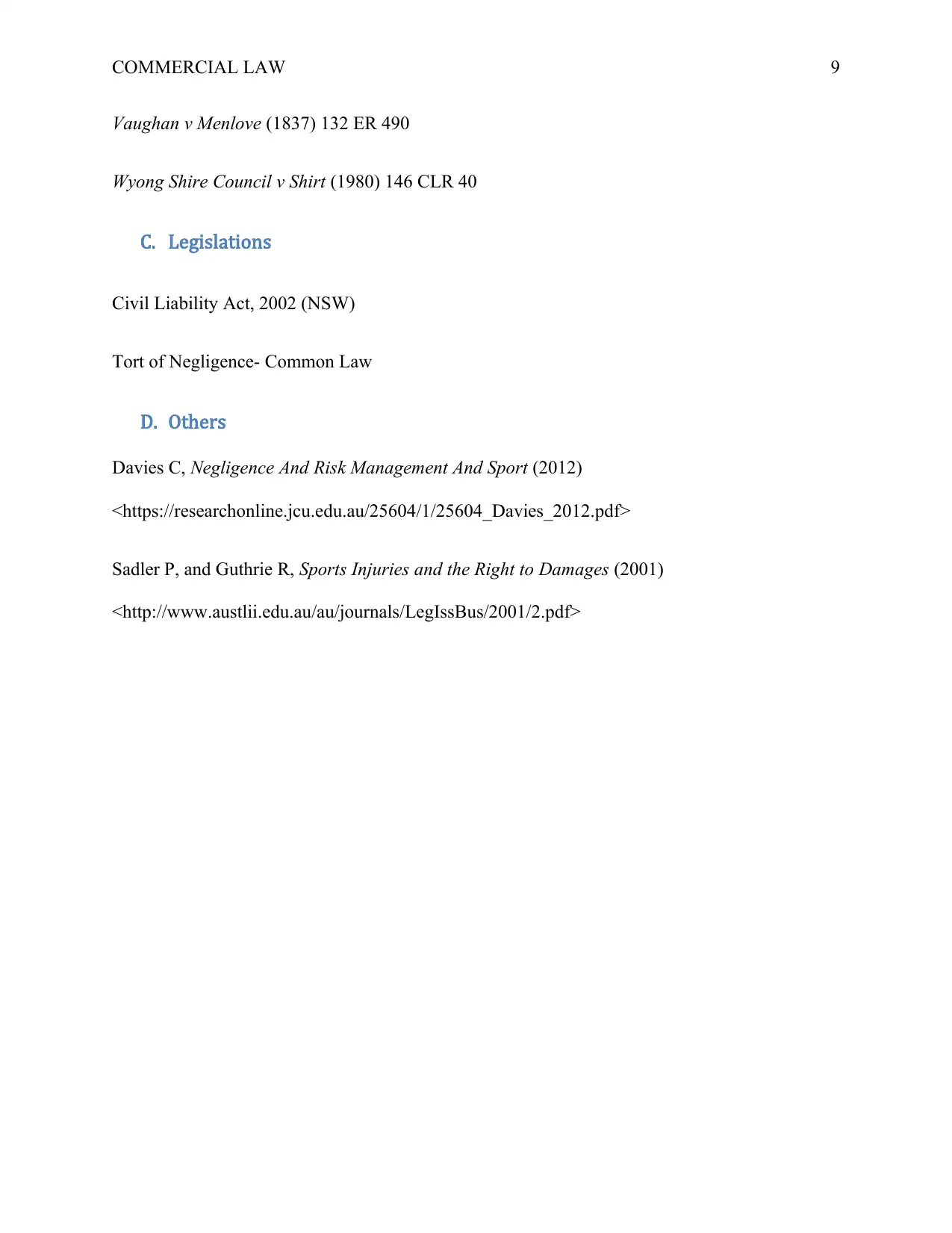
COMMERCIAL LAW 9
Vaughan v Menlove (1837) 132 ER 490
Wyong Shire Council v Shirt (1980) 146 CLR 40
C. Legislations
Civil Liability Act, 2002 (NSW)
Tort of Negligence- Common Law
D. Others
Davies C, Negligence And Risk Management And Sport (2012)
<https://researchonline.jcu.edu.au/25604/1/25604_Davies_2012.pdf>
Sadler P, and Guthrie R, Sports Injuries and the Right to Damages (2001)
<http://www.austlii.edu.au/au/journals/LegIssBus/2001/2.pdf>
Vaughan v Menlove (1837) 132 ER 490
Wyong Shire Council v Shirt (1980) 146 CLR 40
C. Legislations
Civil Liability Act, 2002 (NSW)
Tort of Negligence- Common Law
D. Others
Davies C, Negligence And Risk Management And Sport (2012)
<https://researchonline.jcu.edu.au/25604/1/25604_Davies_2012.pdf>
Sadler P, and Guthrie R, Sports Injuries and the Right to Damages (2001)
<http://www.austlii.edu.au/au/journals/LegIssBus/2001/2.pdf>
1 out of 9
Related Documents
Your All-in-One AI-Powered Toolkit for Academic Success.
+13062052269
info@desklib.com
Available 24*7 on WhatsApp / Email
![[object Object]](/_next/static/media/star-bottom.7253800d.svg)
Unlock your academic potential
© 2024 | Zucol Services PVT LTD | All rights reserved.





